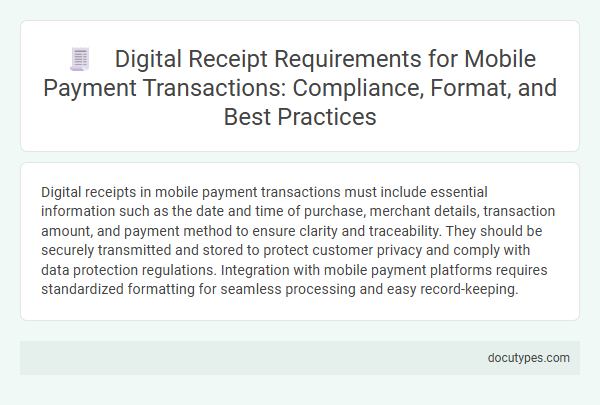Digital receipts in mobile payment transactions must include essential information such as the date and time of purchase, merchant details, transaction amount, and payment method to ensure clarity and traceability. They should be securely transmitted and stored to protect customer privacy and comply with data protection regulations. Integration with mobile payment platforms requires standardized formatting for seamless processing and easy record-keeping.
Introduction to Digital Receipt Requirements for Mobile Payments
Digital receipts in mobile payment transactions serve as electronic proof of purchase, streamlining record-keeping for consumers and merchants. They ensure transparency and enhance the security of financial exchanges in mobile commerce.
Mobile payment systems must generate digital receipts that include transaction details such as date, amount, merchant information, and payment method. Compliance with data protection regulations like GDPR ensures customer information is securely handled. Clear formatting and easy accessibility on mobile devices improve user experience and trust in mobile payment platforms.
Legal and Regulatory Compliance in Digital Receipts
Digital receipts in mobile payment transactions must adhere to specific legal and regulatory requirements to ensure authenticity, security, and consumer protection. Compliance with these standards supports the validity and acceptance of electronic proof of purchase in various jurisdictions.
- Data Privacy Compliance - Digital receipts must comply with laws such as GDPR or CCPA that govern the collection, storage, and sharing of personal and transactional data.
- Receipt Authenticity and Integrity - Digital receipts need to include secure identifiers or digital signatures to prevent tampering and validate the transaction.
- Consumer Rights and Accessibility - Regulatory frameworks often require easy consumer access to receipts and clear disclosure of transaction details to protect buyer rights.
Essential Elements of a Digital Receipt
Digital receipts in mobile payment transactions must include specific essential elements to ensure clarity and compliance. These elements provide a complete record of the transaction for both merchants and customers.
Key components include the merchant's name, transaction date, and total amount paid. Additionally, the payment method, itemized list of purchased products or services, and a unique transaction ID are crucial elements.
Standardized Format Guidelines for Mobile Receipts
Digital receipts in mobile payment transactions must follow standardized format guidelines to ensure clarity and consistency. These guidelines include clear item descriptions, transaction amounts, and timestamps to facilitate easy record-keeping and verification.
The format should be compatible with various devices and apps, supporting both text and barcode elements for seamless integration. Your digital receipt needs to provide essential transaction details in a structured layout that complies with industry standards for security and accessibility.
Security and Privacy Considerations in Digital Receipts
Digital receipts in mobile payment transactions must adhere to stringent security and privacy standards to protect user information. Ensuring confidentiality and preventing unauthorized access are critical for maintaining trust in mobile commerce.
- Data Encryption - Receipts should be encrypted during transmission and storage to safeguard sensitive transaction details from interception.
- Access Control - Only authorized users and systems should have permission to view or manage digital receipts, minimizing risks of data breaches.
- Minimal Data Retention - Retaining only essential information on digital receipts reduces exposure of personal data and complies with privacy regulations.
Mobile Platform Compatibility and Accessibility
Digital receipts in mobile payment transactions must be compatible with major mobile platforms such as iOS and Android to ensure broad user accessibility. They should support various formats like email, SMS, and in-app notifications to accommodate different user preferences and device capabilities. Accessibility features such as screen reader compatibility and adjustable text size enhance usability for all users, including those with disabilities.
Best Practices for Digital Receipt Design
Digital receipts in mobile payment transactions must include clear transaction details such as date, amount, merchant name, and payment method to ensure transparency and trust. Best practices for digital receipt design emphasize concise layout, easy readability on various devices, and secure storage options to protect user data. Your digital receipts should also offer options for email delivery or in-app access to enhance convenience and record-keeping.
Record Keeping and Data Retention Policies
| Requirement | Details |
|---|---|
| Record Keeping | Digital receipts must be securely stored to ensure accurate transaction history and easy retrieval. Records should capture key transaction details such as date, time, merchant information, payment amount, and payment method. Storage solutions should comply with industry standards for data integrity and protection against unauthorized access. |
| Data Retention Policies | Mobile payment providers must establish clear policies defining the duration for which digital receipt data is retained. Retention periods often range from 3 to 7 years, depending on legal and regulatory requirements. Policies should include procedures for secure deletion after the retention period expires, ensuring privacy compliance and minimizing data breach risks. |
Customer Experience and Digital Receipt Delivery Methods
Digital receipts play a crucial role in enhancing customer experience during mobile payment transactions. Ensuring seamless delivery and accessibility of these receipts is essential for consumer satisfaction.
- Clear and Concise Information - Digital receipts must provide detailed transaction data, including item descriptions, prices, and payment methods to avoid confusion.
- Multiple Delivery Options - Offering delivery methods such as email, SMS, app notifications, or QR codes increases convenience for customers.
- Instant Accessibility - Receipts should be available immediately after the transaction to support timely expense tracking and returns.
Optimizing digital receipt requirements enhances transparency and strengthens trust in mobile payment systems.
What Are the Requirements for Digital Receipts in Mobile Payment Transactions? Infographic

